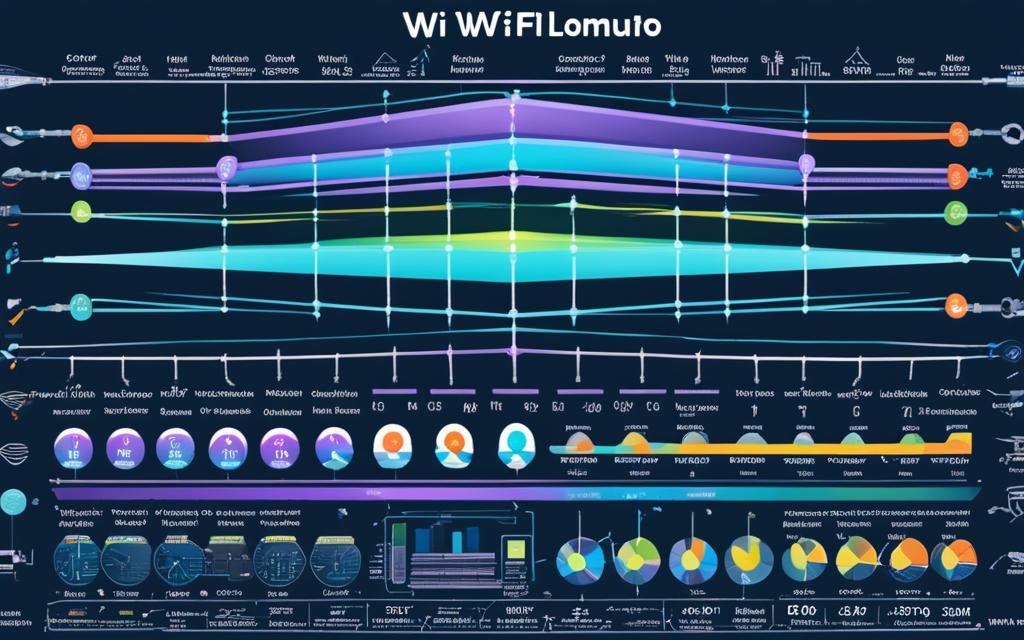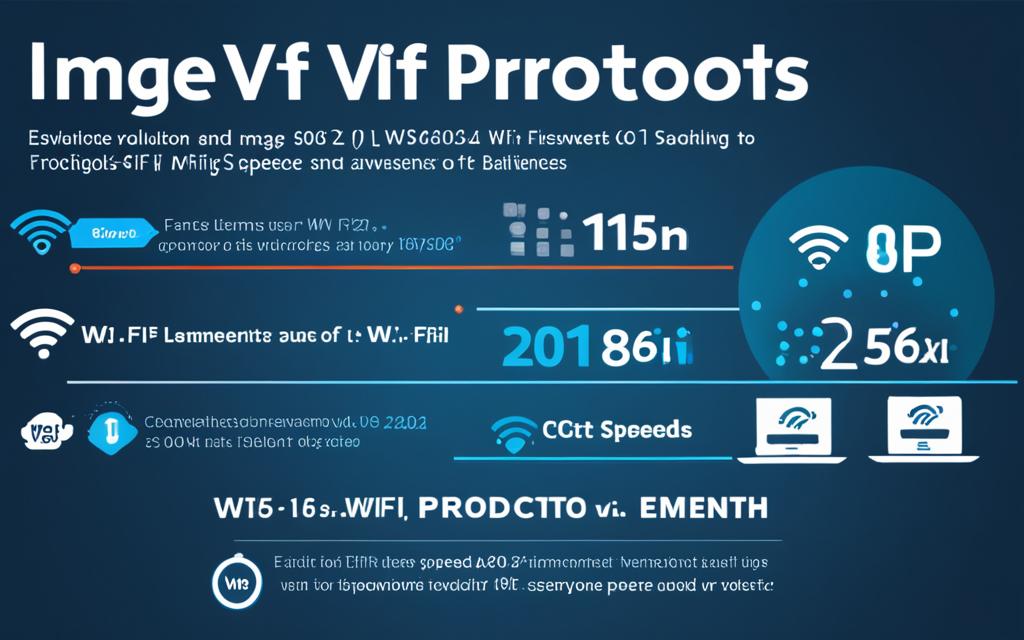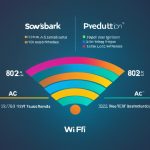Welcome to our in-depth exploration of WLAN Protocols, where we will take a closer look at the evolution of wireless networking standards from the groundbreaking 802.11a to the latest Wi-Fi 6 (802.11ax). As technology continues to evolve, understanding these protocols and their features is crucial in ensuring you have the best wireless network for your needs.
Picture this: lightning-fast internet speeds, seamless connectivity, and unparalleled performance. That’s what the world of WLAN Protocols offers, and we’re here to unravel the secrets behind it. From the early days of 802.11a to the groundbreaking Wi-Fi 6, we’ll guide you through the exciting journey of wireless networking so you can make informed decisions regarding your connectivity.
Get ready to dive deep into the realm of wireless networking standards as we explore the details of 802.11a, the introduction of Wi-Fi 6 (802.11ax), and everything in between. Discover the data rates, capacity, and how these protocols can enhance your connectivity experience. Say goodbye to lag and buffering and hello to a seamless wireless future.
Whether you’re a tech enthusiast or a business owner seeking the best network solution, this comprehensive guide will equip you with the knowledge to navigate the intricacies of WLAN Protocols. Join us as we decode the past, present, and future of wireless networking standards.
The Evolution of WLAN Protocols
The world of wireless networking has witnessed a fascinating evolution of WLAN protocols since the introduction of the O.G. wireless networking specification, IEEE 802.11, in 1997. Each subsequent standard brings improved features and capabilities, catering to the ever-increasing demands of wireless connectivity.
Let’s take a closer look at the timeline of WLAN protocols:
IEEE 802.11
The journey began with the groundbreaking IEEE 802.11 standard, which made its debut in 1997. With data rates of 1-2Mbps, this initial standard paved the way for wireless networking and set the stage for future advancements.
802.11b
The year 1999 marked a significant milestone with the introduction of the 802.11b standard, offering speeds of up to 11Mbps. This was a major leap forward, providing faster and more reliable wireless connectivity for users.
802.11a
The same year witnessed yet another breakthrough with the introduction of 802.11a. This standard operated on a 5GHz frequency, enabling faster speeds of up to 54Mbps. The 802.11a standard took advantage of the less crowded 5GHz band, resulting in improved performance and reduced interference.
802.11g
In 2003, the 802.11g standard was released, combining the range of 802.11b with the speed of 802.11a. With data rates of up to 54Mbps, this standard became widely adopted, offering a balance between coverage and speed.
802.11n
The next major revision came in 2008 with the introduction of 802.11n, also known as Wi-Fi 4. This standard brought significant improvements with speeds ranging from 72Mbps to 600Mbps, thanks to the implementation of Multiple Input Multiple Output (MIMO) technology. 802.11n brought enhanced coverage and performance, making it suitable for bandwidth-intensive applications.
802.11ac
In 2014, the 802.11ac standard, also known as Wi-Fi 5, took wireless networking to new heights. With speeds measuring in gigabits per second, reaching up to 3.46Gbps, this standard offered blazing-fast connectivity. 802.11ac operated on the 5GHz band, providing wider channels and improved performance, especially in dense environments.
To summarize, the evolution of WLAN protocols has brought us from the modest beginnings of IEEE 802.11 to the lightning-fast speeds of 802.11ac. Each generation has built upon previous advancements to deliver better performance, increased range, and improved reliability. Now, with a solid understanding of the historical journey, we can delve into the specifics of the latest standard, Wi-Fi 6 or 802.11ax, in the next section.
Understanding Wi-Fi 6 (802.11ax)
Wi-Fi 6, also known as 802.11ax, is the primary wireless networking standard in use today. Introduced in 2019 and finalized in 2020, Wi-Fi 6 offers a theoretical maximum data rate of up to 10.53Gbps, ushering in a new era of high-speed connectivity. This makes it particularly well-suited for the increasing internet speeds provided by fiber-to-the-home connections.
One of the key objectives of Wi-Fi 6 is to address the challenges of capacity and overcrowding in wireless networks. As the number of connected devices continues to rise, the demand for faster and more reliable connections has become crucial. Wi-Fi 6 tackles this issue by adopting advanced technologies and employing efficient use of available spectrum. It offers a substantial increase in network capacity, allowing multiple devices to connect simultaneously without compromising performance.
Furthermore, Wi-Fi 6 introduces numerous enhancements related to power efficiency, reducing energy consumption and prolonging battery life for devices connected to the network. This is particularly beneficial for IoT devices and other battery-powered devices.
In summary, Wi-Fi 6 (802.11ax) represents a significant advancement in wireless networking technology, offering higher data rates, increased capacity, and improved efficiency. With its ability to support the growing demands of today’s connected world, Wi-Fi 6 is poised to revolutionize the way we stay connected.
PHY Changes in Wi-Fi 6
Wi-Fi 6, also known as 802.11ax, brings significant modifications to the physical layer of wireless networking. This latest standard operates on both the 2.4GHz and 5GHz bands, offering increased flexibility and compatibility. One of the notable improvements in Wi-Fi 6 is the enhanced support for various channel bandwidths, including 20 MHz, 40 MHz, 80 MHz, 80+80 MHz, and 160 MHz.
Additionally, Wi-Fi 6 incorporates larger Fast Fourier Transform (FFT) sizes compared to its predecessor, 802.11ac. The larger FFT sizes enable more efficient data transmission and reception, resulting in improved performance and higher data rates. Alongside this, the subcarrier spacing in Wi-Fi 6 is reduced, allowing for more subcarriers within each channel bandwidth. This optimization contributes to enhanced spectral efficiency and overall network capacity.
Another significant change in Wi-Fi 6 is the increased OFDM (Orthogonal Frequency Division Multiplexing) symbol duration and cyclic prefix. These enhancements enable higher modulation schemes, with the highest being 1024-QAM (Quadrature Amplitude Modulation), leading to greater data rates and improved transmission efficiency.
In summary, the PHY changes in Wi-Fi 6, such as the support for multiple bands, wider channel bandwidths, larger FFT sizes, reduced subcarrier spacing, and increased modulation schemes, contribute to the standard’s ability to achieve higher data rates and accommodate more devices in a wireless network.

| Wi-Fi Specifications | Band(s) | Channel Bandwidth | FFT Sizes | Subcarrier Spacing | OFDM Symbol Duration | Highest Modulation | Data Rates |
|---|---|---|---|---|---|---|---|
| 802.11ac (Wi-Fi 5) | 5GHz | 20 MHz, 40 MHz, 80 MHz, 160 MHz | 64, 128, 256 | N/A | N/A | 256-QAM | 3.46 Gbps |
| 802.11ax (Wi-Fi 6) | 2.4GHz, 5GHz | 20 MHz, 40 MHz, 80 MHz, 80+80 MHz, 160 MHz | 256, 512, 1024 | 26 ns, 13 ns | 4 μs | 1024-QAM | 10.53 Gbps |
Multi-User Operation and Beamforming in Wi-Fi 6
Wi-Fi 6, also known as 802.11ax, introduces advanced features that enhance the performance and efficiency of wireless networks. Two key technologies incorporated in Wi-Fi 6 are Multi-User Multiple Input Multiple Output (MU-MIMO) and Orthogonal Frequency Division Multiple Access (OFDMA). These technologies revolutionize the way devices connect and communicate over Wi-Fi.
MU-MIMO:
MU-MIMO allows for simultaneous transmission and reception of data between multiple devices and the access point. In previous Wi-Fi generations, devices had to take turns accessing the network, leading to slower speeds in crowded environments. With MU-MIMO, Wi-Fi 6 access points can communicate with multiple devices simultaneously, improving performance and reducing latency. This is especially beneficial in environments with a high density of connected devices, such as homes, offices, or public spaces.
OFDMA:
OFDMA is a key technology in Wi-Fi 6 that enables efficient multiplexing of multiple users within the same channel bandwidth. Traditionally, Wi-Fi networks assigned a single channel to each device, resulting in inefficient use of available spectrum. With OFDMA, the available frequency spectrum is divided into smaller subcarriers, allowing multiple users to transmit and receive data simultaneously. This technique significantly improves overall network capacity and ensures a more stable and reliable connection.
Beamforming:
Another important technology in Wi-Fi 6 is beamforming. Beamforming optimizes the communication between the access point and connected devices by directing the RF energy towards each user. This focused transmission improves signal strength and reduces interference, resulting in increased range and better performance. Beamforming also enhances the overall efficiency of the network by minimizing wasted energy.
| MU-MIMO | OFDMA | Beamforming | |
|---|---|---|---|
| Key Features | Simultaneous transmission to multiple devices | Multiplexing of multiple users within the same channel bandwidth | Directed RF energy towards each user |
| Benefits | Improved performance in crowded environments | Increased network capacity and stability | Enhanced signal strength, range, and efficiency |
Wi-Fi 6’s multi-user operation capabilities, powered by MU-MIMO and OFDMA, and the efficiency of beamforming ensure a superior wireless experience for users. These technologies are particularly advantageous in environments with numerous connected devices and high bandwidth demands, such as smart homes, offices, and public Wi-Fi networks.
Coexistence of Legacy Devices with Wi-Fi 6
The IEEE 802.11ax standard introduces the possibility of coexistence between legacy devices and Wi-Fi 6 devices. However, the presence of legacy devices within a Wi-Fi 6 network can have an impact on the overall performance and efficiency of the network.
Legacy devices, which are older devices that adhere to previous Wi-Fi standards such as 802.11a, 802.11b, and 802.11g, may not fully support the advanced features and capabilities offered by the Wi-Fi 6 standard. This can result in reduced speeds, limited capacity, and increased latency within the network.
To mitigate the negative impact of legacy devices, the IEEE 802.11ax standard introduces a mechanism called BSS coloring. BSS coloring allows Wi-Fi 6 devices to differentiate between transmissions from different access points and legacy devices, reducing interference and improving overall network performance.
To optimize the performance of a mixed network comprising Wi-Fi 6 and legacy devices, it is essential to consider various factors and techniques. Network parameters such as channel selection, transmit power settings, and Quality of Service (QoS) configurations can be fine-tuned to ensure optimal performance for both types of devices.
Additionally, techniques like frame aggregation can be employed to improve efficiency and throughput in mixed networks. Frame aggregation involves combining multiple smaller data frames into a single larger frame, reducing overhead and enhancing overall network performance.
Benefits of optimizing Wi-Fi 6 performance in mixed networks:
- Improved speed and throughput
- Enhanced network efficiency
- Reduced latency and response times
- Minimized interference and improved reliability
Example of BSS coloring in a mixed Wi-Fi 6 and legacy device network:
| Device Type | BSS Color |
|---|---|
| Wi-Fi 6 Device 1 | Green |
| Wi-Fi 6 Device 2 | Green |
| Legacy Device 1 (802.11g) | Red |
| Legacy Device 2 (802.11b) | Red |
By assigning different BSS colors to Wi-Fi 6 devices and legacy devices, the network can prioritize Wi-Fi 6 transmissions and minimize interference from legacy devices, resulting in improved overall network performance.
With careful optimization of network parameters, implementation of BSS coloring, and utilization of techniques like frame aggregation, the coexistence of legacy devices with Wi-Fi 6 can be successfully managed, ensuring an efficient and high-performing wireless network.
Conclusion
In conclusion, WLAN Protocols have come a long way since the introduction of the 802.11a standard. From the early days of wireless networking to the latest Wi-Fi 6 standard, significant advancements have been made to provide faster and more reliable wireless connectivity. Understanding the different standards, such as 802.11a, 802.11ax (Wi-Fi 6), and everything in between, is crucial in deciding which wireless network is best suited for your specific needs.
Although the coexistence of legacy devices with Wi-Fi 6 devices can present challenges, implementing optimization techniques and utilizing new network mechanisms can greatly enhance overall network performance. Techniques like BSS coloring and frame aggregation can help mitigate the negative impact of legacy devices, ensuring a smoother and more efficient operation.
As technology continues to evolve, it is important to stay informed about the latest developments in WLAN protocols. With the introduction of Wi-Fi 6, users can expect faster speeds, increased capacity, and improved performance across multiple devices. By keeping up with these advancements, you can ensure your wireless network remains up-to-date and optimized for optimal connectivity.
FAQ
What is the latest wireless networking standard?
The latest wireless networking standard is 802.11ax, also known as Wi-Fi 6, which offers speeds of up to 10.53Gbps.
What were the previous versions of WLAN protocols?
The previous versions of WLAN protocols were 802.11, 802.11b, 802.11a, 802.11g, 802.11n, and 802.11ac.
What are some key features of Wi-Fi 6?
Wi-Fi 6 operates on both the 2.4GHz and 5GHz bands, supports different channel bandwidths, utilizes MU-MIMO and OFDMA technologies for multi-user operation, and employs beamforming for improved performance.
How does Wi-Fi 6 support multi-user operation?
Wi-Fi 6 supports multi-user operation through technologies like MU-MIMO (Multi-User Multiple Input Multiple Output) and OFDMA (Orthogonal Frequency Division Multiple Access), which allow for simultaneous transmission to multiple devices and multiplexing of multiple users within the same channel bandwidth.
Can legacy devices coexist with Wi-Fi 6 devices?
Yes, the IEEE 802.11ax standard allows for the coexistence of legacy devices with Wi-Fi 6 devices. However, the presence of legacy devices can impact network performance.
What techniques can be used to improve network performance in mixed Wi-Fi 6 and legacy device networks?
Techniques such as implementing the BSS coloring mechanism and optimizing network parameters, as well as using frame aggregation, can help improve network performance in mixed Wi-Fi 6 and legacy device networks.



















